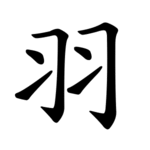| 羽 | ||
|---|---|---|
| ||
| 羽 (U+7FBD) "feather" | ||
| Pronunciations | ||
| Pinyin: | yǔ | |
| Bopomofo: | ㄩˇ | |
| Wade–Giles: | yu3 | |
| Cantonese Yale: | yu5 | |
| Jyutping: | jyu5 | |
| Japanese Kana: | ウ u (on'yomi) はね hane (kun'yomi) | |
| Sino-Korean: | 우 u | |
| Names | ||
| Chinese name(s): | (Left) 羽字旁 yǔzìpáng (Top) 羽字頭/羽字头 yǔzìtóu (Bottom) 羽字底 yǔzìdǐ | |
| Japanese name(s): | 羽/はね hane | |
| Hangul: | 깃 git | |
| Stroke order animation | ||
 | ||
Radical 124 or radical (羽部) meaning "feather" is one of the 29 Kangxi radicals (214 radicals in total) composed of 6 strokes.
In the Kangxi Dictionary, there are 220 characters (out of 49,030) to be found under this radical.
羽 is also the 147th indexing component in the Table of Indexing Chinese Character Components predominantly adopted by Simplified Chinese dictionaries published in mainland China.
YouTube Encyclopedic
-
1/1Views:355
-
Chinese character 羽 (yŭ, feather) with stroke order and pronunciation
Transcription
Evolution
-
Oracle bone script character
-
Bronze script character
-
Large seal script character
-
Small seal script character
Derived characters
| Strokes | Characters |
|---|---|
| +0 | 羽 |
| +3 | 羾 羿 |
| +4 | 翀 翁 翂 翃 翄 (=翅) 翅 翆 (=翠) |
| +5 | 翇 翈 翉 翊 翋 翌 翍 翎 翏 翐 翑 習 |
| +6 | 翓 翔 翕 翖 翗 翘SC (=翹) 翙SC (=翽) 翚SC (=翬) |
| +7 | 翛 翜 翝 |
| +8 | 翞 翟 翠 翡 翢 翣 翤 |
| +9 | 翥 翦 翧 翨 翩 翪 翫 翬 翭 |
| +10 | 翮 翯 翰 翱 |
| +11 | 翲 翳 翴 翵 翶 (=翱) 翼 |
| +12 | 翷 翸 翹 翺 (=翱) 翻 |
| +13 | 翽 翾 |
| +14 | 翿 耀 |
Variant forms
-
Traditional printing form of 羽 in the Kangxi Dictionary
-
The most common written form of 羽 in regular script
-
Regular script imitating the printing form
Traditionally, this radical character is printed as 羽 and written as 羽.
In modern Chinese, both the standard printing form and writing form of this character have been altered to 羽, though the more traditional printing form 羽 is still seen in some Traditional Chinese publication.
In modern Japanese, the Kangxi form (old form) and the written form (new form) are encoded separately in JIS and Unihan (New 羽: U+7FBD; Old 羽: U+FA1E). The new form is used in jōyō kanji while the old form is used in hyōgai kanji, with the exception that in 曜, 耀 and 燿, the component 羽 is replaced by ヨヨ.
| Kangxi Dict. Korean |
Japanese | Simp. Chinese | Trad. Chinese |
|---|---|---|---|
| 翔 | 翔 | 翔 | 翔 |
| 翊 | 翊 | 翊 | 翊 |
| 翌 | 翌 | 翌 | 翌 |
| 曜 | 曜 | 曜 | 曜 |
Sinogram
The radical is also used as an independent Chinese character. It is one of the Kyōiku kanji or Kanji taught in elementary school in Japan.[1] It is a second grade kanji[1]
References
- ^ a b "The Kyoiku Kanji (教育漢字) - Kanshudo". www.kanshudo.com. Archived from the original on March 24, 2022. Retrieved 2023-05-06.
Literature
- Fazzioli, Edoardo (1987). Chinese calligraphy : from pictograph to ideogram : the history of 214 essential Chinese/Japanese characters. calligraphy by Rebecca Hon Ko. New York: Abbeville Press. ISBN 0-89659-774-1.
- Lunde, Ken (Jan 5, 2009). "Appendix J: Japanese Character Sets" (PDF). CJKV Information Processing: Chinese, Japanese, Korean & Vietnamese Computing (Second ed.). Sebastopol, Calif.: O'Reilly Media. ISBN 978-0-596-51447-1.







